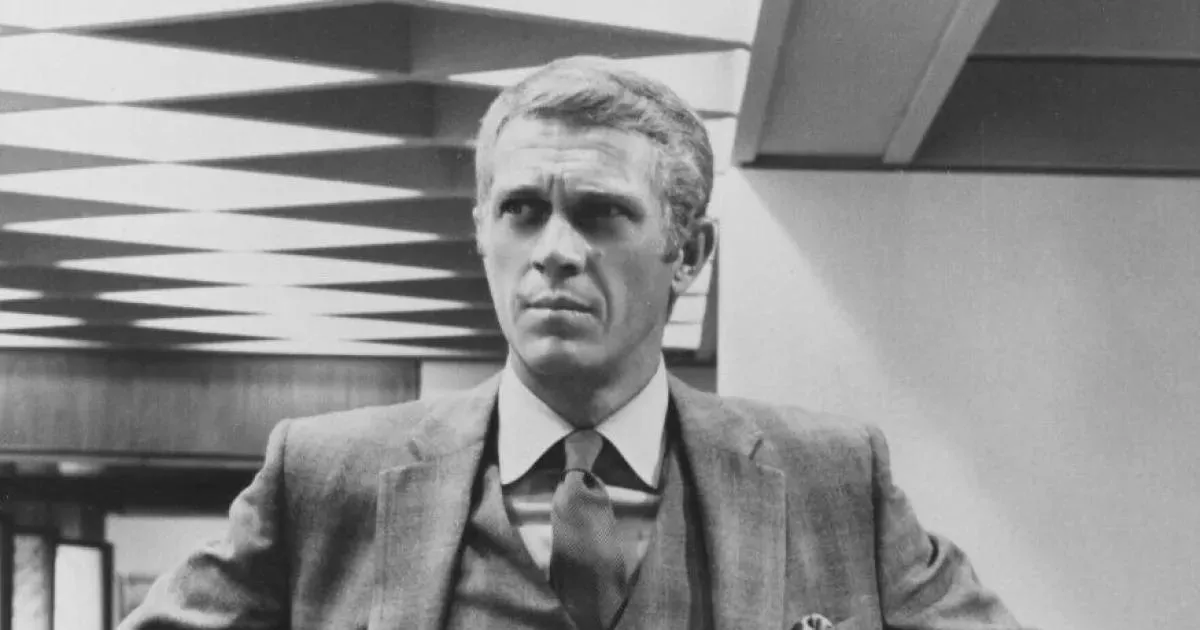March 24, 1930: Birth of Terrence Stephen McQueen
Terrence Stephen McQueen, later known as Steve McQueen, was born on March 24, 1930, at St. Francis Hospital in Beech Grove, Indiana.
1931: McQueen's Pitcairn PA-8 Biplane
Adding to his impressive aircraft collection, Steve McQueen possessed a 1931 Pitcairn PA-8 biplane, a plane previously flown by World War I flying ace Eddie Rickenbacker during his time with the U.S. Mail Service.
1933: Childhood and Relocation
As the Great Depression took hold, a young Steve McQueen and his grandparents relocated to his great-uncle Claude's farm in Slater, Missouri in 1933.
1937: Record-Breaking Sale of McQueen's 1937 Crocker Motorcycle
A 1937 Crocker motorcycle, once owned by Steve McQueen, set a world record when it sold for an astounding $276,500 at an auction.
1945: McQueen's Stearman
Among his collection of aircraft, Steve McQueen owned a 1945 Stearman, with the tail number N3188, which corresponded to his student number during his time at reform school.
1946: McQueen's Piper J-3 Cub
Steve McQueen's passion for aviation extended to owning a 1946 Piper J-3 Cub, demonstrating his interest in various aircraft models.
1947: Enlistment in the Marine Corps
In 1947, at the age of 17, Steve McQueen enlisted in the United States Marine Corps, where he would serve until 1950.
1950: Honorable Discharge from the Marines
Steve McQueen was honorably discharged from the United States Marine Corps in 1950.
1952: Beginnings in Acting
Steve McQueen began studying acting in New York at Sanford Meisner's Neighborhood Playhouse and HB Studio under Uta Hagen in 1952.
1953: Early Television Appearance
During the 1953–1954 season, Steve McQueen appeared as a musical judge on an episode of ABC's Jukebox Jury.
1954: Early Television Appearance
During the 1953–1954 season, Steve McQueen appeared as a musical judge on an episode of ABC's Jukebox Jury.
1955: Move to Los Angeles
In late 1955, Steve McQueen moved from New York to Los Angeles, settling in Echo Park and seeking acting opportunities in Hollywood.
1955: Broadway Debut
Steve McQueen made his Broadway debut in 1955 in the play "A Hatful of Rain," starring Ben Gazzara.
November 2, 1956: McQueen's Marriage to Neile Adams
Steve McQueen married Filipino actress and dancer Neile Adams on November 2, 1956.
1956: First Film Role
Steve McQueen landed his first film role in "Somebody Up There Likes Me" (1956), directed by Robert Wise and starring Paul Newman.
1956: McQueen's Ownership and Display of the 1956 Jaguar XKSS
Steve McQueen's British racing green 1956 Jaguar XKSS, a testament to his love for automobiles, is now part of the Petersen Automotive Museum's collection. The car remains in drivable condition and has even been featured on Jay Leno's Garage.
1957: McQueen's Ownership of the 1957 Chevrolet Convertible
In 1957, Steve McQueen acquired a red 1957 fuel-injected Chevrolet convertible, a car that would later become a highlight in exhibitions showcasing his car collection.
September 1958: Premiere of "Wanted Dead or Alive"
September 1958 marked the premiere of "Wanted Dead or Alive" on CBS, which became Steve McQueen's breakout role.
1958: Success of "Wanted Dead or Alive"
"Wanted Dead or Alive" ran for 94 episodes from 1958 to early 1961, solidifying Steve McQueen's presence in Hollywood.
1958: Breakthrough on "Tales of Wells Fargo"
Steve McQueen's first notable role was in Dale Robertson's NBC Western series "Tales of Wells Fargo," playing the character Bill Longley in 1958.
June 5, 1959: Birth of Terry Leslie McQueen
On June 5, 1959, Steve McQueen and Neile Adams welcomed their daughter, Terry Leslie McQueen.
1959: Mamie Van Doren's Alleged Affair with McQueen
Mamie Van Doren claimed to have had an affair with Steve McQueen around 1959 and experimenting with hallucinogens together.
December 28, 1960: Birth of Chad McQueen
Steve McQueen and Neile Adams's son, Chad McQueen, was born on December 28, 1960.
1960: The Magnificent Seven
Steve McQueen starred in "The Magnificent Seven" in 1960, a major hit that further propelled his career, alongside Yul Brynner, Eli Wallach, and others.
1961: Conclusion of "Wanted Dead or Alive"
"Wanted Dead or Alive" ran for 94 episodes from 1958 to early 1961, solidifying Steve McQueen's presence in Hollywood.
1961: British Touring Car Championship Race
In 1961, Steve McQueen ventured into the realm of professional racing, participating in the British Touring Car Championship. Driving a BMC Mini at Brands Hatch, he secured an impressive third-place finish.
1963: Love with the Proper Stranger
In 1963, Steve McQueen starred alongside Natalie Wood in the film "Love with the Proper Stranger."
1963: The Great Escape
In 1963, Steve McQueen starred in "The Great Escape," a fictionalized account of a mass escape from Stalag Luft III, a World War II POW camp. While the film is known for its iconic motorcycle jump, insurance concerns prevented McQueen from performing the stunt, which was instead done by his friend and fellow motorcycle enthusiast, Bud Ekins. The film was a box-office success and helped solidify McQueen's superstar status.
1963: McQueen's Ownership of the 1963 Ferrari 250 GT Lusso Berlinetta
The year 1963 marked Steve McQueen's ownership of a 1963 metallic-brown Ferrari 250 GT Lusso Berlinetta, a car that would later become a prized collector's item.
1964: The Diamond Smugglers Consideration
According to spy novelist Jeremy Duns, Steve McQueen was considered for the lead role in a film adaptation of "The Diamond Smugglers," a novel penned by James Bond creator Ian Fleming. The role in question was John Blaize, a secret agent tasked with infiltrating a diamond-smuggling operation in South Africa. Despite the existence of a screenplay dating back to 1964, the project faced numerous obstacles and was ultimately shelved.
1964: Lauren Hutton's Alleged Affair with McQueen
Actress and model Lauren Hutton stated that she had an affair with Steve McQueen around 1964.
1964: McQueen's Support for Lyndon B. Johnson
Despite being a registered Republican, Steve McQueen supported Lyndon B. Johnson in the 1964 U.S. presidential election.
1964: McQueen's Participation in International Six Days Trial
In 1964, Steve McQueen, alongside Bud Ekins and others, formed the first official U.S. team to enter the Silver Vase category of the International Six Days Trial in East Germany. They modified Triumph motorcycles for the off-road competition.
1965: The Cincinnati Kid
In 1965, McQueen starred in "The Cincinnati Kid" as a poker player.
1966: The Sand Pebbles and Academy Award Nomination
In 1966, Steve McQueen received his only Academy Award nomination for his role as an engine room sailor in "The Sand Pebbles." This film saw him star opposite Candice Bergen and Richard Attenborough, with whom he had previously worked on "The Great Escape."
1968: The Thomas Crown Affair and The Reivers
Following the success of "Bullitt," Warner Bros. attempted to mend their relationship with McQueen, but he declined their advances. His subsequent project was an independent film, "The Thomas Crown Affair," released by United Artists in 1968. In this film, McQueen portrayed a wealthy executive alongside Faye Dunaway. The following year, he appeared in "The Reivers," a period piece set in the Southern United States.
1968: Bullitt
In 1968, Steve McQueen starred in "Bullitt," a film that would become one of his most iconic and a personal favorite. The film, which co-starred Jacqueline Bisset, Robert Vaughn, and Don Gordon, featured a groundbreaking and often-imitated car chase through the streets of San Francisco. While McQueen did some of the driving, most of the chase sequences were filmed with stunt drivers Bud Ekins and Loren Janes. McQueen's character drove a 1968 Ford Mustang GT 390, while the antagonist drove a black Dodge Charger. "Bullitt" went significantly over budget, leading Warner Bros. to cancel McQueen's contract for his remaining seven films.
1968: McQueen's Support for Richard Nixon
Steve McQueen's political leanings shifted as he supported Richard Nixon in the 1968 U.S. presidential election.
1968: McQueen's Signature Sunglasses in "The Thomas Crown Affair"
The year 1968 marked the release of the heist film "The Thomas Crown Affair," starring Steve McQueen. In the film, McQueen sported a pair of blue-tinted Persol 714 sunglasses, which would later become synonymous with his iconic style.
1968: Release of "Bullitt" Featuring the Iconic Mustang Chase Scene
The year 1968 saw the release of the action thriller "Bullitt," starring Steve McQueen. The film became renowned for its iconic car chase scene featuring a 1968 Mustang Fastback, forever linking McQueen to the legendary vehicle.
1970: McQueen's Acquisition of the Porsche 911S During "Le Mans" Filming
During the production of the racing film "Le Mans" in 1970, Steve McQueen purchased a 1970 Porsche 911S, which would later gain recognition for its appearance in the movie's opening sequence.
1970: McQueen's Motorcycle Racing and Movie Commitments
In 1970, Steve McQueen had to decline an offer to co-drive in the London-Mexico rally due to his movie commitments. However, he continued to participate in off-road motorcycle races, showcasing his passion for the sport.
1970: 12 Hours of Sebring and Le Mans
In 1970, Steve McQueen participated in the 12 Hours of Sebring race, partnering with Peter Revson. Despite driving with a cast on his left foot due to a recent motorcycle accident, McQueen and Revson emerged victorious in the three-liter class, narrowly missing the overall win by a mere 21.1 seconds. Their Porsche 908/02 was edged out by a five-liter Ferrari 512S driven by Mario Andretti, Ignazio Giunti, and Nino Vaccarella. McQueen's production company, Solar Productions, later entered the same Porsche 908 as a camera car for the 1970 24 Hours of Le Mans. Although McQueen had aspirations of driving a Porsche 917 alongside Jackie Stewart in the race, the film's financial backers threatened to withdraw their support if he proceeded. Faced with a difficult decision—dedicating 24 hours to the race or committing an entire summer to film production—McQueen ultimately opted for the latter.
1971: Neile Adams's Abortion
As revealed in her autobiography, Neile Adams shared that she had an abortion in 1971 while her marriage with Steve McQueen was facing difficulties.
1971: Le Mans
In 1971, Steve McQueen starred in the auto-racing drama "Le Mans." The film received mixed reviews from critics.
1971: Release of McQueen's Racing Film "Le Mans"
In 1971, Steve McQueen's passion for motorsports culminated in the release of the racing film "Le Mans," a project he was deeply involved in both in front of and behind the camera.
1971: McQueen's Involvement in "On Any Sunday" and Sports Illustrated Cover
In 1971, Steve McQueen's production company funded the motorcycle documentary "On Any Sunday," featuring him alongside racing legends. He also graced the cover of Sports Illustrated magazine riding a Husqvarna dirt bike.
1971: McQueen's Motorsports Seat Patent
Reflecting his passion for motorsports, Steve McQueen designed a bucket seat for which he received a patent in 1971.
1971: McQueen's Heuer Monaco Watch in "Le Mans"
Steve McQueen's role as a sponsored ambassador for Heuer watches, particularly his choice to wear a blue-faced Heuer Monaco Ref. 1133 in the 1971 film "Le Mans," significantly contributed to the watch's cult following among collectors. To ensure continuity during filming, McQueen acquired six watches of the same model.
1971: McQueen's Relationship with Barbara Leigh
While separated from his wife, Neile Adams, Steve McQueen was involved with Barbara Leigh, his co-star in "Junior Bonner," in 1971. The relationship led to a pregnancy and subsequent abortion.
1972: McQueen's Divorce from Neile Adams
After 16 years of marriage, Steve McQueen and Neile Adams divorced in 1972.
1972: First Blood Role Declined
Following the publication of David Morrell's novel "First Blood" in 1972, Steve McQueen expressed interest in portraying the main character, Rambo. However, the producers ultimately decided against casting him due to his age.
1972: Junior Bonner
In 1972, Steve McQueen starred in "Junior Bonner," a film about an aging rodeo rider.
1972: End of McQueen's Relationship with Barbara Leigh
Steve McQueen's relationship with Barbara Leigh ended in 1972.
1972: McQueen's Arrest for DUI
Steve McQueen's struggles with alcohol abuse led to his arrest for driving under the influence in Anchorage, Alaska, in 1972.
1973: The Getaway and Papillon
1973 saw Steve McQueen star in two films: "The Getaway" and "Papillon." "The Getaway" provided the opportunity for McQueen to work with director Sam Peckinpah once again. It was also during this film's production that he met his future wife, Ali MacGraw. In "Papillon," McQueen took on the physically demanding role of a prisoner on Devil's Island, starring alongside Dustin Hoffman.
1973: McQueen's Marriage to Ali MacGraw
Steve McQueen married actress Ali MacGraw, his co-star in "The Getaway," in Cheyenne, Wyoming, in 1973.
1973: McQueen as a Pallbearer at Bruce Lee's Funeral
Steve McQueen was among the pallbearers at Bruce Lee's funeral in 1973, demonstrating their close friendship.
1974: Quigley Down Under Consideration
As early as 1974, Steve McQueen's name was circulating as a potential lead for the film "Quigley Down Under." However, by the time production was set to begin in 1980, McQueen's health had deteriorated, forcing him to withdraw from consideration. The project was subsequently put on hold for a decade, eventually moving forward with Tom Selleck in the lead role.
1974: The Towering Inferno
In 1974, Steve McQueen co-starred with Paul Newman in the disaster film "The Towering Inferno," directed by John Guillermin. McQueen portrayed a fire chief tasked with containing a fire that erupts in a skyscraper. Although initially approached to play the architect, who serves as the film's other hero, McQueen opted for the role of the fire chief, believing it to be a more captivating part. To ensure a balance in dialogue with Paul Newman, who ultimately took on the architect role, McQueen requested additional lines for his character. For his role in "The Towering Inferno," McQueen received a salary of $1,000,000, along with a percentage of the film's gross earnings. True to his nature, he insisted on performing his own stunts. The film achieved considerable success, amassing $55,000,000 in North American box office receipts.
1974: Private Ownership of the Original "Bullitt" Mustang
In 1974, the original 1968 Mustang Fastback used in the filming of "Bullitt" went into private ownership, remaining hidden from public view for decades.
1976: The Bodyguard Offer
Steve McQueen was presented with the opportunity to star in "The Bodyguard" alongside Diana Ross when the project was in its early stages in 1976. However, production on the film faced significant delays and did not commence until well after McQueen's death. Ultimately, the roles were filled by Kevin Costner and Whitney Houston in the 1992 release.
1976: Revocation of William Donald Kelley's Medical License
William Donald Kelley, who provided unconventional cancer treatments to Steve McQueen, had his only medically related license, which was for orthodontics, revoked in 1976.
1977: Sorcerer Casting Decision
Director William Friedkin had initially envisioned Steve McQueen for the lead role in the action thriller "Sorcerer" (1977). However, the film's primary shooting location in the Dominican Republic presented a challenge for McQueen, as he was reluctant to be separated from Ali MacGraw for the duration of the shoot. In an attempt to salvage the situation, McQueen proposed that MacGraw be brought on board as a producer, enabling her to be present during principal photography. Friedkin, however, declined this request, ultimately choosing to cast Roy Scheider in McQueen's place. Friedkin later expressed his belief that the decision not to cast McQueen had a detrimental impact on the film's box office performance.
1977: McQueen's Attempt to Purchase the "Bullitt" Mustang
Steve McQueen's attempt to purchase the remaining Ford Mustang GT 390 from the movie "Bullitt" in 1977 was unsuccessful. The car remained hidden from public view.
1978: An Enemy of the People
In 1978, Steve McQueen returned to acting after a hiatus from the public eye, during which he dedicated his time to motorcycle racing. He took on the role of a bearded, bespectacled 19th-century doctor in "An Enemy of the People," an adaptation of the Henrik Ibsen play. This marked a departure from his typical roles. While the film did not receive a proper theatrical release, it was occasionally broadcasted on PBS.
1978: McQueen's Divorce from Ali MacGraw
Steve McQueen and Ali MacGraw's marriage ended in divorce in 1978.
1978: McQueen's Persistent Cough and Health Concerns
Steve McQueen started experiencing a persistent cough in early 1978. Despite quitting smoking and undergoing antibiotic treatment, his condition didn't improve, and his breathing difficulties worsened.
1978: McQueen's Induction into Off-road Motorsports Hall of Fame
Steve McQueen's contributions to off-road motorcycling were acknowledged in 1978 when he was inducted into the Off-road Motorsports Hall of Fame.
December 22, 1979: McQueen's Mesothelioma Diagnosis
Following the filming of "The Hunter," Steve McQueen underwent a biopsy on December 22, 1979, revealing pleural mesothelioma, a type of cancer linked to asbestos exposure and with a poor prognosis.
January 16, 1980: McQueen's Marriage to Barbara Minty
Less than a year before his death, Steve McQueen married model Barbara Minty on January 16, 1980.
February 1980: McQueen's Cancer Metastasis
By February 1980, Steve McQueen's mesothelioma had spread significantly.
March 11, 1980: Public Disclosure of McQueen's Cancer
Despite attempts to keep his condition private, the National Enquirer revealed Steve McQueen's terminal cancer diagnosis on March 11, 1980.
July 1980: McQueen's Unconventional Treatment in Mexico
After receiving a grim prognosis from U.S. doctors, Steve McQueen traveled to Rosarito Beach, Mexico, in July 1980 to pursue alternative cancer treatment from William Donald Kelley.
October 1980: McQueen's Illness and Travel to Mexico for Treatment
In October 1980, Steve McQueen, battling an abdominal tumor, traveled to Ciudad Juárez, Mexico, for treatment. Despite warnings from his U.S. doctors about the risks, he sought surgery at a clinic in Juárez, where he used an alias to shield his identity.
November 7, 1980: Death of Steve McQueen
Steve McQueen, renowned American actor and racing driver, passed away on November 7, 1980.
1980: Tom Horn and The Hunter
Steve McQueen's final two films, both released in 1980, drew inspiration from real-life events. In "Tom Horn," a Western adventure, he portrayed a former Army scout turned professional gunman hired by cattle ranchers to hunt down rustlers. The film follows Horn's eventual demise as he is hanged for the murder of a sheepherder. "The Hunter" presented McQueen as a modern-day bounty hunter in an urban action setting.
1980: Raise the Titanic and The Towering Inferno 2 Decisions
While Steve McQueen expressed initial interest in the lead role for "Raise the Titanic," he ultimately declined the offer, finding the script uninspiring. Following his appearance in "The Towering Inferno," he remained under contract with Irwin Allen, who offered him a role in a proposed sequel in 1980. McQueen rejected this offer as well. The sequel was subsequently scrapped, and Allen collaborated with Paul Newman on "When Time Ran Out," a film that performed poorly at the box office. Tragically, McQueen passed away shortly after declining the role in "The Towering Inferno 2."
1995: Display of McQueen's 1957 Chevrolet Convertible at the Petersen Automotive Museum
From 1995 to 2011, the Petersen Automotive Museum in Los Angeles hosted a special exhibition dedicated to Steve McQueen's car collection. Among the displayed vehicles was his striking red 1957 fuel-injected Chevrolet convertible.
March 19, 1998: Death of Terry Leslie McQueen
Steve McQueen's daughter, Terry Leslie McQueen, passed away on March 19, 1998.
1998: Ford Puma Commercial Featuring Steve McQueen
In 1998, Ford paid homage to Steve McQueen's iconic role in "Bullitt" by featuring him in a commercial for the Ford Puma. Through the use of archive footage and digital effects, McQueen was seamlessly integrated into modern-day San Francisco, driving the Puma. The commercial cleverly incorporated elements from "Bullitt," such as the Mustang's license plate and a glimpse of a motorcycle reminiscent of "The Great Escape."
November 1999: McQueen's Induction into the Motorcycle Hall of Fame
In November 1999, Steve McQueen's passion for motorcycling and his contributions to the sport were recognized with his induction into the Motorcycle Hall of Fame. He was celebrated for his support of off-road racing, his role in the film "On Any Sunday," and his positive influence on the public perception of motorcycling.
2005: Ford Mustang Commercial Featuring Steve McQueen's Likeness
Ford once again utilized Steve McQueen's enduring appeal in a 2005 commercial for the Mustang. The commercial depicts a farmer constructing a racetrack, which he then drives on in the new Mustang. McQueen appears, and the farmer hands him the keys, allowing him to take the wheel. McQueen's presence was made possible through the use of a body double and advanced digital editing techniques, with Ford obtaining the rights to use his likeness from his estate.
2006: Auction of McQueen's Sunglasses from "The Thomas Crown Affair"
The blue-tinted Persol 714 sunglasses worn by Steve McQueen in the 1968 film "The Thomas Crown Affair" were a hot commodity at a Bonhams & Butterfield auction in Los Angeles in 2006. The iconic eyewear fetched an impressive $70,200, reflecting their cultural significance and McQueen's enduring legacy in the world of style.
2006: Auction of a Portion of McQueen's Motorcycle Collection
Three motorcycles from Steve McQueen's extensive collection, along with other memorabilia, were auctioned off in 2006. However, the majority of his vast collection, comprising around 130 motorcycles, was sold four years after his passing.
April 2007: McQueen's Induction into the Hall of Great Western Performers
In April 2007, Steve McQueen was honored for his contributions to Western cinema with an induction into the Hall of Great Western Performers at the National Cowboy & Western Heritage Museum.
August 16, 2007: Auction of McQueen's 1963 Ferrari 250 GT Lusso Berlinetta
On August 16, 2007, Steve McQueen's 1963 metallic-brown Ferrari 250 GT Lusso Berlinetta was auctioned off, fetching a remarkable US$2.31 million.
2007: McQueen's Enduring Popularity and High Earnings After Death
In 2007, Forbes recognized Steve McQueen's enduring star power, noting his continued status as a popular icon and one of the highest-earning deceased celebrities. His estate's strategic management, including limiting the licensing of his image, was credited with maintaining his appeal and preventing overexposure.
June 11, 2009: Record-Breaking Auction of McQueen's Rolex Submariner
On June 11, 2009, a Rolex Submariner, Reference 5512, often photographed being worn by Steve McQueen, was sold at auction for a world-record price of $234,000, highlighting his influence on the world of horology.
March 16, 2010: Dedication of the Steve McQueen Birthplace Collection
On March 16, 2010, the Beech Grove, Indiana, Public Library paid tribute to Steve McQueen by formally dedicating the Steve McQueen Birthplace Collection in honor of the 80th anniversary of his birth, which took place on March 24, 1930.
August 2011: Auction of McQueen's Porsche 911S from "Le Mans"
In August 2011, the 1970 Porsche 911S that Steve McQueen acquired during the making of "Le Mans" and prominently featured in the film's opening sequence was sold at auction for an impressive $1.375 million.
2012: McQueen's Posthumous Honor with the Warren Zevon Tribute Award
In 2012, the Asbestos Disease Awareness Organization (ADAO) posthumously honored Steve McQueen with the Warren Zevon Tribute Award.
2015: Release of "Steve McQueen: The Man & Le Mans" Documentary
The 2015 documentary "Steve McQueen: The Man & Le Mans" delves into the actor's relentless pursuit to create and star in the 1971 racing film "Le Mans." The film features interviews with individuals like his son, Chad McQueen, and former wife, Neile Adams, offering insights into McQueen's dedication to the project.
September 28, 2017: Selected Theatrical Showings of "Steve McQueen – American Icon"
On September 28, 2017, select theaters presented "Steve McQueen – American Icon," a film exploring the life and spiritual journey of the renowned actor.
October 10, 2017: Encore Presentation of "Steve McQueen – American Icon"
Due to popular demand, "Steve McQueen – American Icon" was re-released for an encore presentation in select theaters on October 10, 2017, following a successful initial showing.
2017: Discovery of the "Bullitt" Mustang
One of the Ford Mustang GT 390s used in "Bullitt," once thought to be scrapped, resurfaced in Mexico in 2017.
January 2018: Unveiling of the 2019 Ford Mustang Bullitt
At the January 2018 Detroit Auto Show, Ford unveiled the 2019 Mustang Bullitt, paying tribute to the iconic car driven by Steve McQueen in the film "Bullitt." McQueen's granddaughter, actress Molly McQueen, had the honor of introducing the tribute car.
June 2018: Controversy Surrounding McQueen's Rolex Submariner Auction
In June 2018, Phillips announced the upcoming auction of a Rolex Submariner associated with Steve McQueen. However, controversy arose regarding the watch's authenticity, with questions raised about whether it was McQueen's personal timepiece or a watch he had gifted. As a result of the controversy, Phillips ultimately withdrew the watch from the auction.
2018: Unrestored "Bullitt" Mustang Display
The surviving, unrestored Ford Mustang GT 390 from "Bullitt" was showcased at the 2018 North American International Auto Show alongside the 2019 Ford Mustang "Bullitt."
August 2019: Announcement of the "Bullitt" Mustang Auction
Mecum Auctions made an exciting announcement in August 2019, revealing that the legendary "Bullitt" Mustang, driven by Steve McQueen in the film, would be auctioned off at their Kissimmee event scheduled for January 2–12, 2020.
2019: McQueen Portrayed by Damian Lewis in Tarantino's "Once Upon a Time in Hollywood"
Actor Damian Lewis took on the role of Steve McQueen in Quentin Tarantino's 2019 film "Once Upon a Time in Hollywood," which also features McQueen as a character in its novel adaptation of the same name.
2019: Release of the 2019 Ford Mustang "Bullitt"
Ford paid homage to the iconic "Bullitt" Mustang by releasing a special edition in 2019.
December 12, 2020: Record-Breaking Auction of McQueen's Heuer Monaco Watch
On December 12, 2020, a blue-faced Heuer Monaco Ref. 1133, one of the six watches worn by Steve McQueen during the filming of "Le Mans" and one of only two in private hands, was auctioned by Phillips in New York City. The watch achieved a record-breaking price of US$2.208 million, solidifying its status as the most expensive Heuer watch ever sold at auction.
2020: Auction of the "Bullitt" Mustang Hero Car
The highly anticipated auction of the "Bullitt" Mustang Hero Car took place in January 2020 at Mecum Auctions' Kissimmee event. The car, offered without reserve, fetched a staggering $3.4 million, which rose to $3.74 million after commissions and fees.
2023: Cost of McQueen's Unconventional Treatment (2023 Equivalent)
Steve McQueen's unconventional cancer treatments from William Donald Kelley were estimated to have cost over $40,000 monthly during his three-month stay in Mexico, which would be equivalent to approximately $148,000 per month in 2023.
September 11, 2024: Death of Chad McQueen
Chad McQueen, Steve McQueen's son, died on September 11, 2024.
Mentioned in this timeline

Whitney Houston nicknamed The Voice was a highly acclaimed American...
CBS Broadcasting Inc CBS is a prominent American commercial broadcast...

Wells Fargo Company is a multinational financial services institution operating...
Sports Illustrated SI is an American sports magazine launched in...

San Francisco is a major commercial financial and cultural hub...
The National Broadcasting Company NBC is a major American commercial...
Trending

2 months ago Belichick Eyes Wake Forest Amidst Giants Job Rumors: McDaniels Also in the Mix?
3 months ago Rigetti Computing Stock Soars as Billionaires Invest in Quantum Future.

6 months ago JD Vance to promote Trump's agenda bill in Pennsylvania next week.

7 months ago Elysée Denies Macron Slapped by Brigitte in Vietnam; Claims Playful Moment

2 months ago Brandon Ingram's Potential Move to Raptors & Wednesday's 16-Point Performance
BBC Sport is the sports broadcasting arm of the British Broadcasting Corporation delivering national sports coverage across television radio and...
Popular

Stranger Things created by the Duffer Brothers is a popular...

XXXTentacion born Jahseh Dwayne Ricardo Onfroy was a controversial yet...

Kelsey Grammer is an accomplished American actor producer and singer...

Candace Owens is an American conservative political commentator and author...

Bernie Sanders is a prominent American politician currently serving as...

Melania Trump a Slovenian-American former model has served as First...
